Abstract
OBJECTIVES: To examine the variation of symptoms from the neck, shoulders, and back over a three year period among female nursing personnel and the relation between job strain and musculoskeletal symptoms. METHODS: At a county hospital the female nursing personnel answered a questionnaire at baseline and then once a year over a period of three years. There were 565, 553, 562, and 419 subjects who answered the questionnaire at the first, second, third, and fourth survey, respectively. Of the study group, 285 nursing personnel answered the questionnaire on four occasions. Ongoing symptoms of the neck, shoulders, and back were assessed by means of a 10 point (0-9) scale with the verbal end points "no symptoms" and "very intense symptoms." Cases were defined as nursing personnel reporting ongoing symptoms, score > 6, from at least one of the body regions. For assessments of job strain, a Swedish version of Karasek and Theorell's model was used. RESULTS: Of the 285 subjects, 13% were defined as cases at all four assessments, and 46% varied between cases and not cases during the study period. In the repeated cross sectional surveys the estimated rate ratio (RR) for being a case was between 1.1 and 1.5 when comparing the group with job strain and the group without job strain. For the combination of job strain and perceived high physical exertion the estimated RR was between 1.5 and 2.1. When the potential risk factors were assessed one, two, or three years before the assessment of symptoms the estimated RR for becoming a case was between 1.4 and 2.2 when comparing the group with job strain and the group without job strain. CONCLUSION: Almost half of the healthcare workers varied between being a case and not, over a three year period. The analysis indicated that job strain is a risk factor for musculoskeletal symptoms and that the risk is higher when it is combined with perceived high physical exertion.
Full text
PDF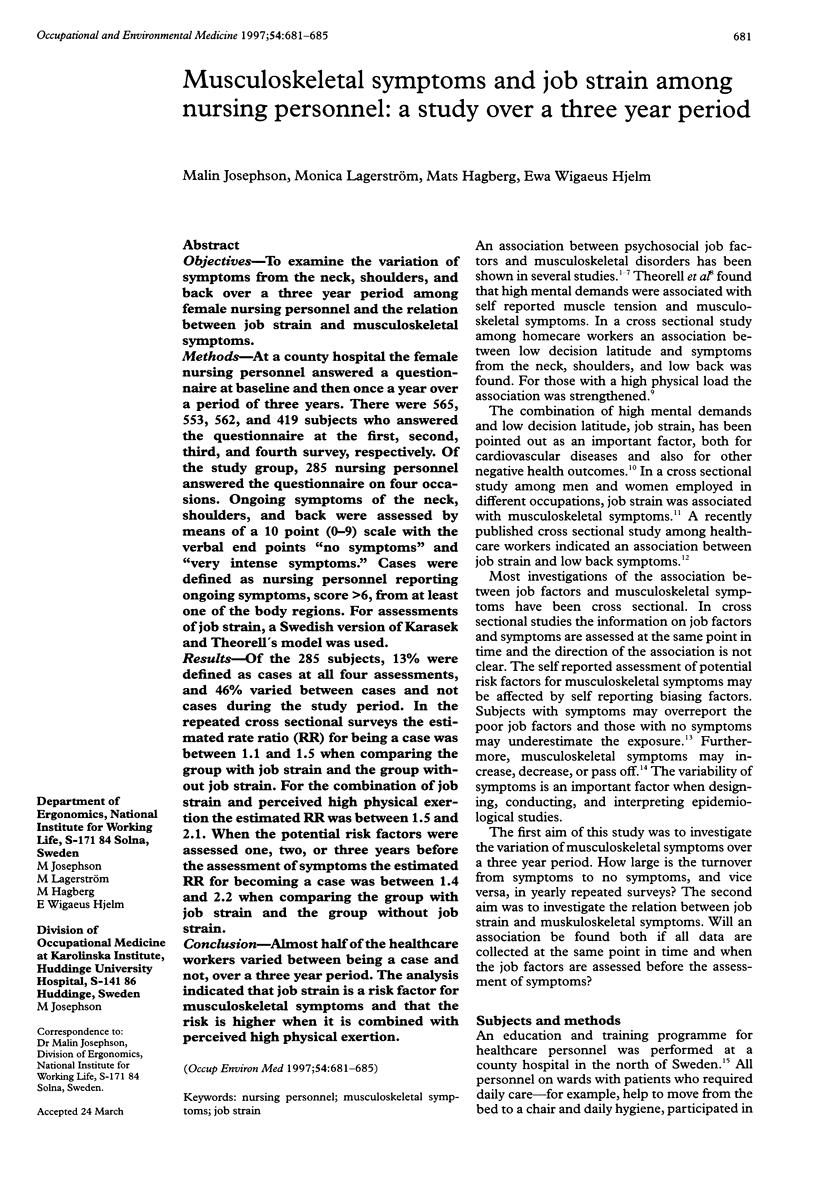
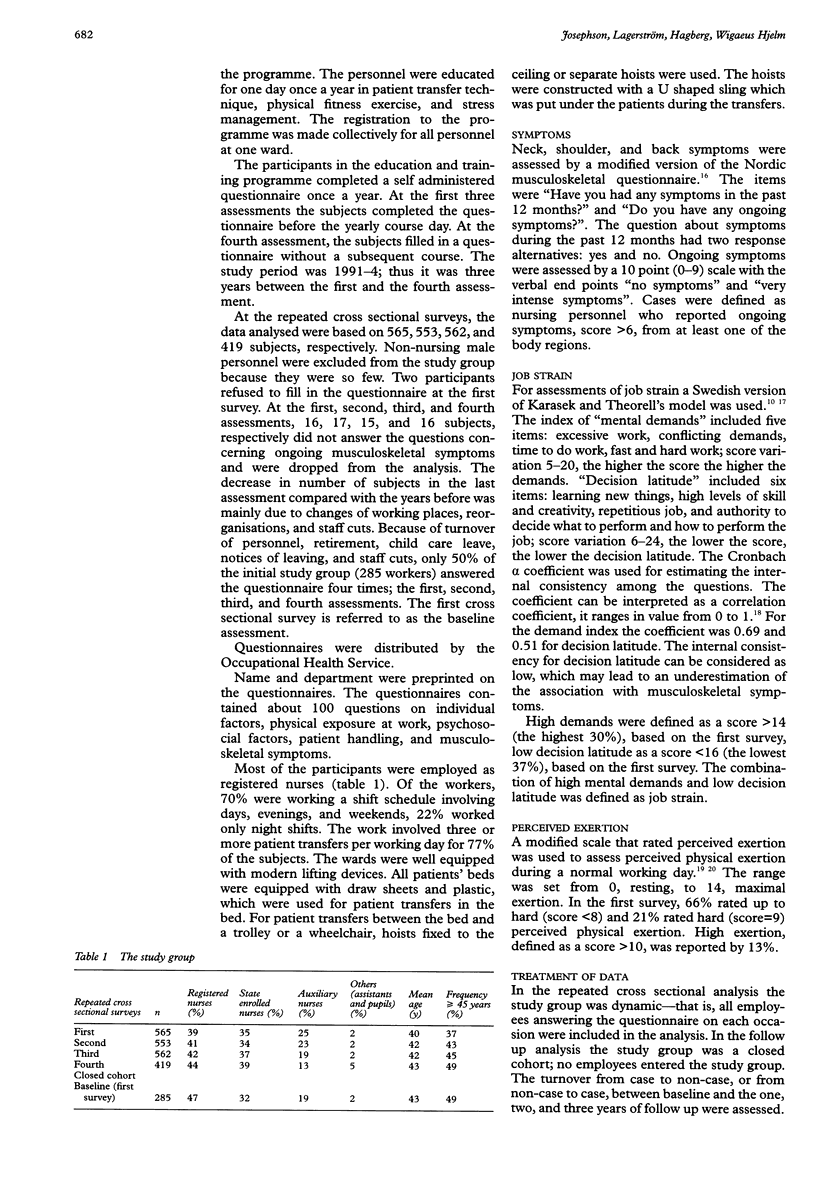
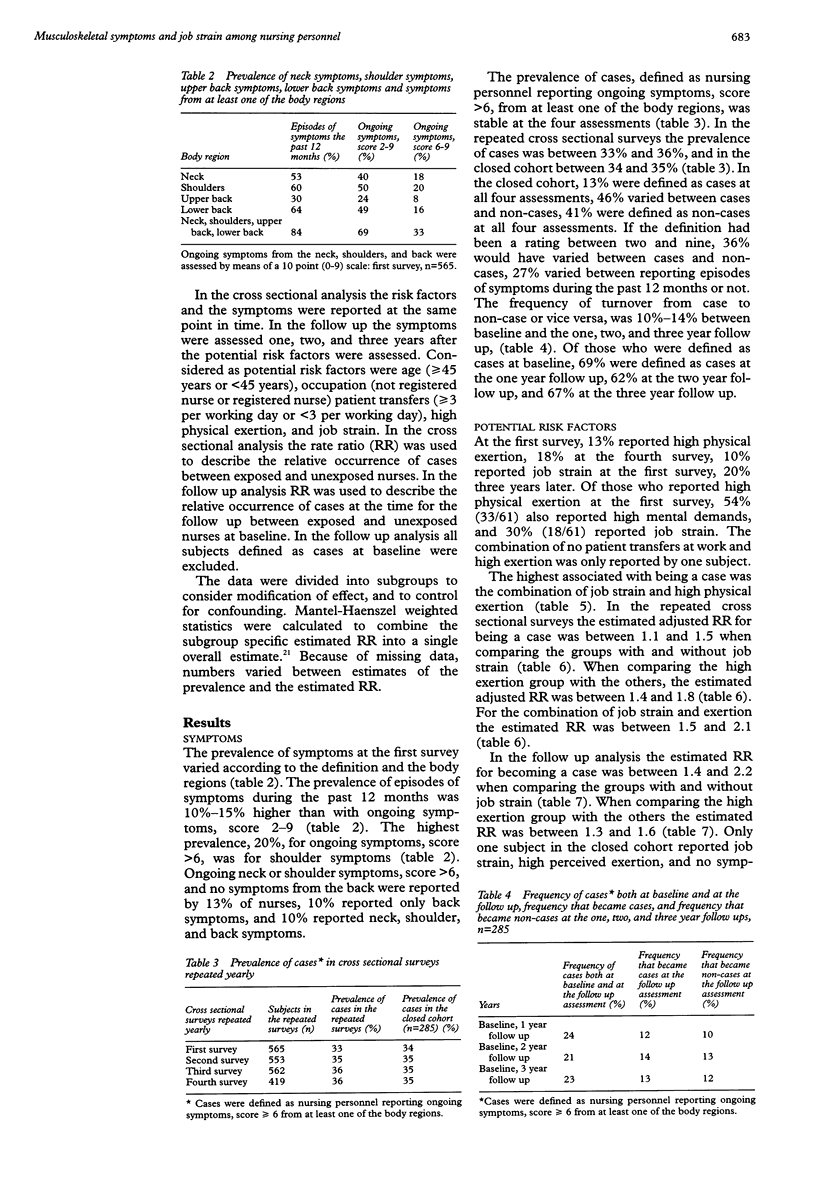
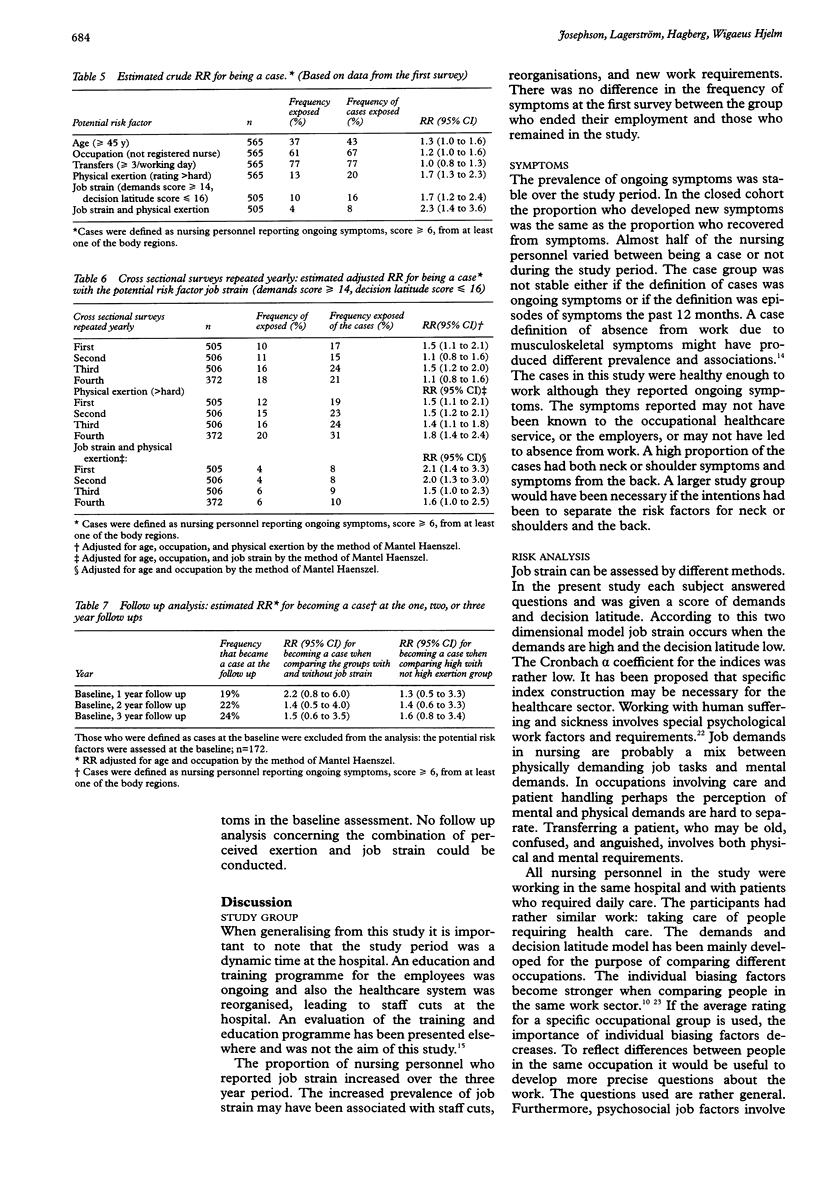
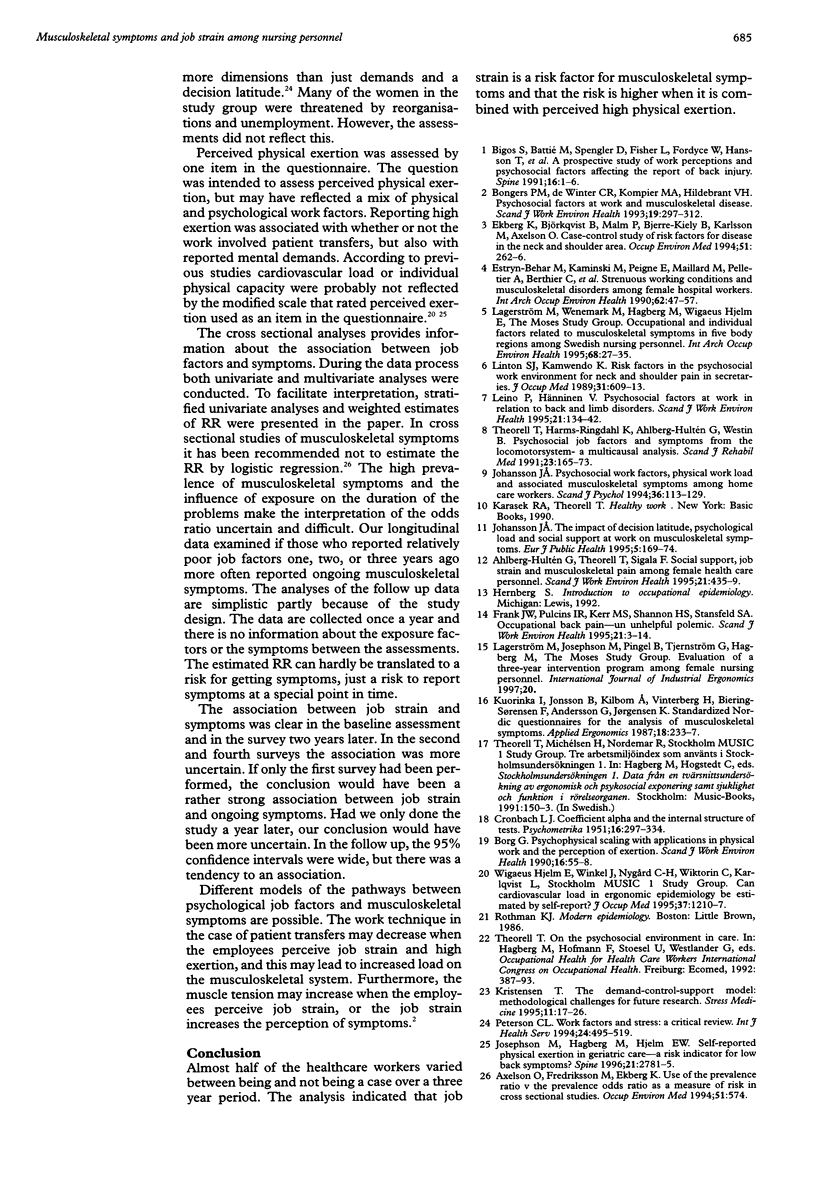
Selected References
These references are in PubMed. This may not be the complete list of references from this article.
- Ahlberg-Hultén G. K., Theorell T., Sigala F. Social support, job strain and musculoskeletal pain among female health care personnel. Scand J Work Environ Health. 1995 Dec;21(6):435–439. doi: 10.5271/sjweh.59. [DOI] [PubMed] [Google Scholar]
- Axelson O., Fredriksson M., Ekberg K. Use of the prevalence ratio v the prevalence odds ratio as a measure of risk in cross sectional studies. Occup Environ Med. 1994 Aug;51(8):574–574. doi: 10.1136/oem.51.8.574. [DOI] [PMC free article] [PubMed] [Google Scholar]
- Bongers P. M., de Winter C. R., Kompier M. A., Hildebrandt V. H. Psychosocial factors at work and musculoskeletal disease. Scand J Work Environ Health. 1993 Oct;19(5):297–312. doi: 10.5271/sjweh.1470. [DOI] [PubMed] [Google Scholar]
- Borg G. Psychophysical scaling with applications in physical work and the perception of exertion. Scand J Work Environ Health. 1990;16 (Suppl 1):55–58. doi: 10.5271/sjweh.1815. [DOI] [PubMed] [Google Scholar]
- Ekberg K., Björkqvist B., Malm P., Bjerre-Kiely B., Karlsson M., Axelson O. Case-control study of risk factors for disease in the neck and shoulder area. Occup Environ Med. 1994 Apr;51(4):262–266. doi: 10.1136/oem.51.4.262. [DOI] [PMC free article] [PubMed] [Google Scholar]
- Estryn-Behar M., Kaminski M., Peigne E., Maillard M. F., Pelletier A., Berthier C., Delaporte M. F., Paoli M. C., Leroux J. M. Strenuous working conditions and musculo-skeletal disorders among female hospital workers. Int Arch Occup Environ Health. 1990;62(1):47–57. doi: 10.1007/BF00397848. [DOI] [PubMed] [Google Scholar]
- Frank J. W., Pulcins I. R., Kerr M. S., Shannon H. S., Stansfeld S. A. Occupational back pain--an unhelpful polemic. Scand J Work Environ Health. 1995 Feb;21(1):3–14. doi: 10.5271/sjweh.2. [DOI] [PubMed] [Google Scholar]
- Hjelm E. W., Winkel J., Nygård C. H., Wiktorin C., Karlqvist L. Can cardiovascular load in ergonomic epidemiology be estimated by self-report? Stockholm MUSIC 1 Study Group. J Occup Environ Med. 1995 Oct;37(10):1210–1217. doi: 10.1097/00043764-199510000-00012. [DOI] [PubMed] [Google Scholar]
- Johansson J. A. Psychosocial work factors, physical work load and associated musculoskeletal symptoms among home care workers. Scand J Psychol. 1995 Jun;36(2):113–129. doi: 10.1111/j.1467-9450.1995.tb00973.x. [DOI] [PubMed] [Google Scholar]
- Josephson M., Hagberg M., Hjelm E. W. Self-reported physical exertion in geriatric care. A risk indicator for low back symptoms? Spine (Phila Pa 1976) 1996 Dec 1;21(23):2781–2785. doi: 10.1097/00007632-199612010-00014. [DOI] [PubMed] [Google Scholar]
- Kuorinka I., Jonsson B., Kilbom A., Vinterberg H., Biering-Sørensen F., Andersson G., Jørgensen K. Standardised Nordic questionnaires for the analysis of musculoskeletal symptoms. Appl Ergon. 1987 Sep;18(3):233–237. doi: 10.1016/0003-6870(87)90010-x. [DOI] [PubMed] [Google Scholar]
- Lagerström M., Wenemark M., Hagberg M., Hjelm E. W. Occupational and individual factors related to musculoskeletal symptoms in five body regions among Swedish nursing personnel. Int Arch Occup Environ Health. 1995;68(1):27–35. doi: 10.1007/BF01831630. [DOI] [PubMed] [Google Scholar]
- Leino P. I., Hänninen V. Psychosocial factors at work in relation to back and limb disorders. Scand J Work Environ Health. 1995 Apr;21(2):134–142. doi: 10.5271/sjweh.20. [DOI] [PubMed] [Google Scholar]
- Linton S. J., Kamwendo K. Risk factors in the psychosocial work environment for neck and shoulder pain in secretaries. J Occup Med. 1989 Jul;31(7):609–613. doi: 10.1097/00043764-198907000-00012. [DOI] [PubMed] [Google Scholar]
- Peterson C. L. Work factors and stress: a critical review. Int J Health Serv. 1994;24(3):495–519. doi: 10.2190/3B3C-XJPP-47LA-XQUJ. [DOI] [PubMed] [Google Scholar]
- Theorell T., Harms-Ringdahl K., Ahlberg-Hultén G., Westin B. Psychosocial job factors and symptoms from the locomotor system--a multicausal analysis. Scand J Rehabil Med. 1991;23(3):165–173. [PubMed] [Google Scholar]


